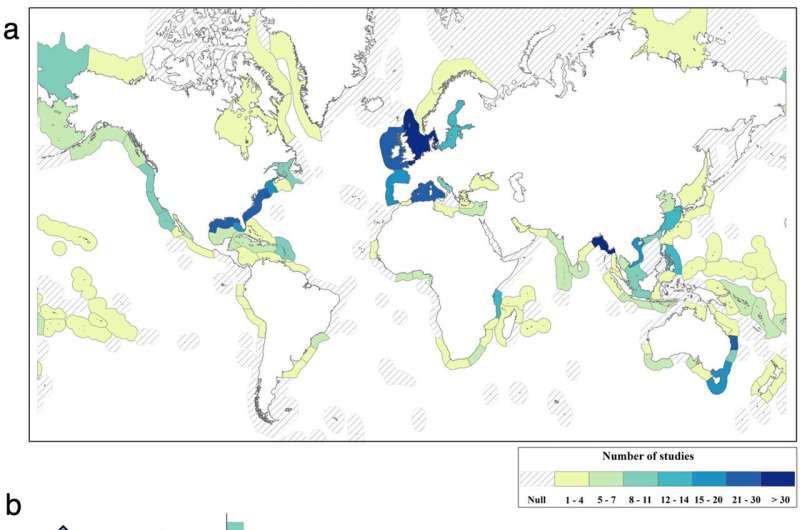This article has been reviewed according to Science X's editorial process and policies. Editors have highlighted the following attributes while ensuring the content's credibility:
fact-checked
peer-reviewed publication
trusted source
proofread
Enabling climate change adaptation in coastal systems

In recent years, there has been a proliferation of scientific publications on how coasts can adapt to the impacts of climate change. However, a study led by marine biologist Dr. David Cabana of the Climate Service Center Germany (GERICS) at the Helmholtz-Zentrum Hereon has revealed a significant gap: few of these research findings translate into actionable recommendations.
The main reason for this discrepancy lies in the limited consideration of economic factors and poor contextualization within coastal policy and governance instruments. The research is published in the journal Earth's Future.
There are a wide range of critical challenges facing the world's coastlines in the coming decades as a result of climate change. These include flooding, heightened storm intensity, coastal erosion, salinization of coastal aquifers, and substantial repercussions on human settlements and vital infrastructure. Many researchers are working to find solutions to protect the coasts and develop strategies to help coastal dwellers adapt to these threats.
However, as the recent study by experts from the Climate Service Center Germany (GERICS) at Hereon shows, many of these research findings are not reaching the people who need them—politicians, authorities responsible for coastal protection, other decision-makers or potential donors. Furthermore, as the researchers note, the situation on the coasts of industrialized nations and the global North has been the main focus of research to date. For many coastal areas in developing countries and the global South, there have been no or only a few studies to date.
Analysis of 650 specialist articles
For its study, the team led by marine biologist David Cabana analyzed a total of 650 scientific publications dealing with the adaptation of coastal areas to climate change. "Such studies are very important for the future management of coastal habitats," says Cabana. "However, many authors set one-sided priorities or ignore aspects completely."
This starts with the global distribution of these studies. The coasts of Europe, North America and Oceania are particularly well studied. There are comparatively few studies on adaptation for the west coast of Africa or the small island states in the Pacific. Another shortcoming of many publications is that they look at the situation on very small, localized stretches of coastline. "However, coastal protection and climate adaptation must also be considered on a regional basis," says Cabana.
As an example, he cites the ports of the Baltic Sea, which are closely interconnected via shipping traffic and the transportation of goods. "It's not enough to investigate how to protect a single port against rising sea levels. You need a solution for the entire Baltic Sea region." This regional aspect was only addressed in about 2% of the publications examined.
Stocktaking instead of concrete proposals
Scientific findings are extremely important for the adaptation of coasts to climate change. They provide a basis for policymakers and the responsible authorities to ultimately implement the right climate protection and coastal management measures. However, 65% of the studies examined only deal with the current situation. Only 19% address the planning of adaptation and just 1% deal with how the measures can be implemented.
Today, marine spatial planning and integrated coastal zone management are among the most important instruments for shaping or using coasts. Essentially, the aim is to harmonize the objectives of interest groups—in the German Bight, for example, shipping, wind power, the designation of marine protected areas or the extraction of sand and gravel. In this respect, it would make sense for researchers working on climate adaptation to also focus on marine spatial planning and integrated coastal zone management in their studies.
Cabana says, "But this is usually not the case. The results of the studies are disconnected from this and are difficult to place in this management context." In addition, few studies focus on the economic viability of climate adaptation. This also makes it difficult to derive measures from scientific findings.
The topic of the "blue economy" has gained momentum in Europe and worldwide in recent years—the question of how to make even better use of the services provided by the sea with sustainable business models. David Cabana therefore recommends focusing on the practical benefits of research in future and designing studies in such a way that clear recommendations for action can be derived from them for coastal management.
More information: David Cabana et al, Enabling Climate Change Adaptation in Coastal Systems: A Systematic Literature Review, Earth's Future (2023). DOI: 10.1029/2023EF003713
Journal information: Earth's Future
Provided by Helmholtz Association of German Research Centres





















